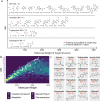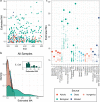Identifying molecules as biosignatures with assembly theory and mass spectrometry
- PMID: 34031398
- PMCID: PMC8144626
- DOI: 10.1038/s41467-021-23258-x
Identifying molecules as biosignatures with assembly theory and mass spectrometry
Abstract
The search for alien life is hard because we do not know what signatures are unique to life. We show why complex molecules found in high abundance are universal biosignatures and demonstrate the first intrinsic experimentally tractable measure of molecular complexity, called the molecular assembly index (MA). To do this we calculate the complexity of several million molecules and validate that their complexity can be experimentally determined by mass spectrometry. This approach allows us to identify molecular biosignatures from a set of diverse samples from around the world, outer space, and the laboratory, demonstrating it is possible to build a life detection experiment based on MA that could be deployed to extraterrestrial locations, and used as a complexity scale to quantify constraints needed to direct prebiotically plausible processes in the laboratory. Such an approach is vital for finding life elsewhere in the universe or creating de-novo life in the lab.
Conflict of interest statement
The authors declare no competing interests.
Figures




References
-
- Ballou EV, Wood PC, Wydeven T, Lehwalt ME, Mack RE. Chemical interpretation of Viking Lander 1 life detection experiment. Nature. 1978;271:644–645. doi: 10.1038/271644a0. - DOI
-
- Selsis, F., Despois, D. & Parisot, J. P. Signature of life on exoplanets: can Darwin produce false positive detections? Astron. and astrophys.388, 985–1003 (2002).
Publication types
MeSH terms
LinkOut - more resources
Full Text Sources
Other Literature Sources
Miscellaneous

